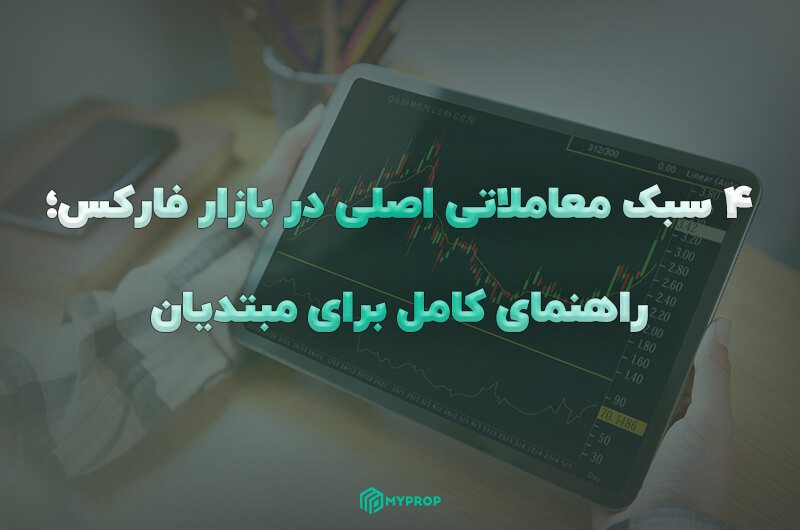The forex market, as one of the largest financial markets in the world, is a place where many transactions are carried out daily. Traders in this market use different styles to carry out their transactions; Trading style in forex refers to the methods and strategies that a trader uses to make his trades. These styles have differences and each one is determined based on various factors such as trading timing, risk tolerance and financial goals of the trader.
why is choosing a trading style important?
Trading styles allow traders to reduce the risk of their trades as much as possible and get more returns from their trades. The trading style you choose should suit your trading personality and respond to your needs in the financial markets. Each trading style is suitable for certain conditions and goals, and its correct choice will keep the trader away from common mistakes in trading and is one of the most important decisions he must make. In the following, we briefly describe the 4 main trading styles in the forex market.

4 main types of trading styles in the forex market
In the forex market, there are 4 main trading styles, each of which is classified based on the duration of trading and different strategies. These styles include:
Position Trading
Position trading style is a market trading method that focuses on holding assets for a long period of time. In this style, traders hold their positions for longer periods of time, usually from several weeks to several months, in order to take advantage of the growth and increase in the value of assets in the long term. Traders in this style simultaneously use technical and fundamental analysis to make decisions in transactions; Fundamental analysis to evaluate the intrinsic value of assets and technical analysis to identify the appropriate entry and exit points for the transaction.
In the trading style of position trading, traders do not pay attention to short-term fluctuations in the market and have a long-term vision for their transactions.
Advantages of position trading style
High profit potential in the long term: One of the most prominent advantages of position trading is the possibility of earning high profits in the long term. Position traders identify strong market trends and by entering them in the early stages, and holding their positions until these trends bear fruit, take advantage of large price changes in the market and earn large profits.
Reduction of trading costs: in the position trading style, due to the smaller number of transactions compared to the daily and short-term styles, transaction costs such as commissions, spreads and other costs of order execution are minimized.
Reducing risk from short-term volatility: Position traders focus on medium- and long-term market trends. Holding assets for the long term allows traders to be less affected by temporary market changes and to be safe from the negative effects of short-term volatility.
Less need for continuous market monitoring: Another advantage of position trading is less need for continuous market monitoring. Instead of focusing on momentary and short-term fluctuations, position traders focus on mid-term to long-term market trends, and with comprehensive analysis and long-term strategies, they will not need to constantly check and follow up on the moment of the market.
Disadvantages of position trading style
High risk due to long-term holding of trades: One of the main disadvantages of position trading is the high risk of long-term holding of trades. Although this style reduces the risk of short-term fluctuations, it brings other risks. Various factors such as macroeconomic changes, political developments, financial crises or changes in laws and regulations can significantly affect the value of assets. Due to the long period of holding assets in position trading, it is more difficult to manage and predict these risks.
Need for strong analytical skills: Success in position trading requires strong analytical skills and deep and comprehensive analysis of long-term market trends. Position traders must be able to understand and analyze fundamental data, such as financial reports, macroeconomic trends and policies, in order to make strategic and correct decisions in their trades. Also, mastering technical analysis is necessary to find suitable entry and exit points in transactions and predict market trends. Not mastering these things will cause a lot of losses for traders.
High cost of maintaining transactions: Another disadvantage of position trading is the high costs of maintaining transactions. In this trading style, positions are held for long periods of time, which means incurring ongoing costs. These costs include trading fees, spreads, swaps and account margin related costs.
Swing Trading
Swing trading style refers to a strategy in which traders keep their positions open for several days to several weeks and seek to exploit medium-term market fluctuations. The main goal of a swing trader is to profit from market fluctuations and price changes that occur in the medium term. Swing traders often use hourly, daily or weekly time frames for their transactions, and by using different indicators, they look for bullish and bearish patterns that may last several days to several weeks.
This trading style requires strong technical analysis to accurately identify patterns, although traders must stay tuned to events and news that can cause volatility in the market. In swing trading, accurate and deep analysis of the market is preferable to continuous monitoring. Traders in this style determine their goals by determining the profit limit and the loss limit before entering the transaction, and there is no need for continuous monitoring of the market. Therefore, this style of trading is suitable for people who do not have the possibility of continuous access to the market.
Advantages of swing trading style
Less need for continuous monitoring of the market: in swing trading, after determining the entry and exit points and determining the profit and loss limits, there is no need to continuously monitor the market.
The possibility of exploiting mid-term fluctuations: Traders with swing trading style take advantage of mid-term market fluctuations and earn significant profits in a period of several days to several weeks.
Less risk: in swing trading, traders use price changes in medium-term time frames; This reduces the impact of short-term and unexpected fluctuations.
Less psychological pressure: swing traders can spend less time in the market by determining entry and exit points and using profit and loss limits, and can focus on their long-term goals with less concern about short-term market fluctuations. do
Disadvantages of swing trading style
The risk of price gaps: one of the most prominent disadvantages of swing trading is the risk of price gaps, which can have significant effects on the trading results. Price chats usually occur when the market is closed and as soon as it reopens, prices change suddenly due to news or unexpected events. These price changes can cause swing trades to not proceed as expected.
Fees and transaction costs: Another disadvantage of swing trading is the fees and transaction costs. In swing trading, due to keeping positions open for several days or weeks, traders are required to pay a commission to the broker, and in addition there are buying and selling spreads, these items can reduce the overall profit of trading.
Possibility of losing opportunities: Another disadvantage of swing trading is the possibility of losing quick and short-term trading opportunities. In swing trading, the focus is on the medium-term volatility of the market, and profit opportunities that require the exploitation of short and fast fluctuations may be ignored.

Day Trading
Day trading is one of the most widely used forex trading styles used by many traders. Traders who use the Day Trading style enter and exit the market several times during a trading day. At the end of a trading day, these traders close all their positions and do not keep them until the next day. Day traders also use short-term time frames to analyze and enter trades in order to have a good view of the market and to be able to close their position within a few trading candles in a day.
The main goal of this trading style is to profit from short-term price fluctuations throughout the day, and traders in this style make the most of even the smallest price movements in the market. Day trading style trading is a full-time job and requires constant monitoring, you have to spend a lot of time analyzing the market and finding the right positions to enter and exit trades.
Advantages of day trading style
Quick profit potential: Day traders can make a large number of trades during a day and due to the high number of trades and taking advantage of short-term market fluctuations, they have the potential to make quick profits from the market.
Avoiding the risk of long-term holding: Another advantage of the day trading style in the forex market is avoiding the risk of holding long-term trading, because in this style, traders close all their positions at the end of the day from unexpected overnight fluctuations, bad economic news. or avoid major investment changes.
More control over trades: Day traders have more control over their trades due to continuous market analysis and can react to market changes faster. This style allows traders to better manage their risks and protect their capital by setting profit limits and loss limits.
Disadvantages of the day trading style
High risk: Day traders face a lot of volatility due to the frequent entry and exit of trades during the day, which can quickly lead to losses in trades. Also, opening a large number of transactions during the day increases the possibility of making wrong decisions.
The need for time and high concentration: Day traders must constantly and carefully follow the price changes in the market, charts and news so that they can make quick decisions and make the most of the opportunities in the market. This work requires high concentration and accuracy and can be tiring and stressful in the long run.
High transaction costs: One of the challenges of the day trading style is the high transaction costs caused by the high number of transactions during the day. Every transaction in the forex market includes a fee, and in addition to that, other costs such as spreads and order execution costs can also be effective.
Scalping transactions
Scalping trading style means profiting from very small price fluctuations in short periods of time; It involves making a large number of trades in a single day with the aim of making small and quick profits. Scalpers keep their trading positions open only for a very short period of time, from a few seconds to a few minutes, and focus on technical analysis and rapid price changes.
Scalpers need to have the ability to react quickly and be highly focused because traders in this style need to make quick decisions in order to respond to market changes and take advantage of short-term market fluctuations. This trading style may bring high mental pressure and stress and is usually more suitable for professional and experienced traders.
Advantages of scalping trading style
Potential for quick profits: One of the most important advantages of this trading style is the potential for quick and frequent profits. Scalpers make many trades during a day, and each of these trades, even with small profits, can add up to a significant profit.
Reduction of overall risk: In scalping trades, traders hold their positions for only a few seconds to a few minutes, which reduces the overall risk. By holding fewer positions in the market, traders in this style avoid large and sudden fluctuations that may occur over longer periods of time and minimize the risks associated with these changes.
No dependence on long-term trends: Another advantage of scalping transactions is the lack of need to predict and analyze long-term trends in the market. In this style, the focus is on short-term fluctuations and minor price changes, and scalpers can exploit small price movements without the need for complex analysis of fundamentals and long-term trends.
Disadvantages of scalping trading style
Very high transaction costs: one of the most important disadvantages of scalping transactions is the high commission and spread costs. Scalpers make many trades throughout the day and face many trading fees. These fees can add up quickly and cut into trading profits. Also, the transaction spread (the difference between the purchase and sale price) is also added to the transaction costs and affects the profit of each transaction.
Need for concentration and high speed of action: Scalping style trading requires a high level of concentration and the ability to react quickly to market changes. This can create high psychological pressure because every moment there is a delay in decision-making, profitable opportunities may be lost or significant losses may occur.

How to compare forex trading styles?
To compare trading styles in the forex market, the trader must know his abilities and needs well and determine under what conditions and with what goals he intends to trade. By specifying these items, you can choose the most suitable trading style. For novice traders, the best approach is to first identify their abilities, goals and limitations well, and then choose the most suitable style based on their personality and abilities.
Effective factors in choosing a trading style
Risk tolerance: risk tolerance is one of the critical factors in choosing a trading style; The higher your risk tolerance, the more risky styles you can choose, such as scalping or day trading. On the other hand, traders with lower risk tolerance may tend to styles such as swing or position trading.
Time: The amount of time a trader can devote to his trading activities directly affects his trading style. For example, the scalping trading style requires continuous monitoring of the market and quick decisions during the day, so it is suitable for people who are able to spend a lot of time during the day for trading in the market. In contrast to long-term and position trading styles, they require less attention and time during the day, so they are suitable for people who have little time to follow the market.
Financial goals: Financial goals are very important in choosing a trading style; Because for people who are looking for quick and short-term profits, scalping and daily styles are more suitable, and on the other hand, long-term trading style is suitable for people who are looking for bigger profits in the long term.
Individual personality: the psychological and behavioral characteristics of each person have a direct impact on how to manage transactions and face market fluctuations; Characteristics such as stress tolerance, patience, time management ability and ability to make decisions under pressure, all play a fundamental role in choosing the right trading style for a trader.
final word
In this article from the MyProp website , we examined the four main trading styles in the forex market and examined the unique features of each. Each of these styles is suitable for a specific type of trader. Also, we introduced the important and effective factors in choosing a trading style, including risk tolerance, time, financial goals and individual personality of the trader. Accurate knowledge of these factors will help traders to choose the most appropriate trading style that is most compatible with their individual needs and conditions.
